More watches!
This page contains many large and beautiful pictures. May take sometime to load due to the images. Please wait, you will find it worth your while.
Some watches of special interest
Ulysee Nardin
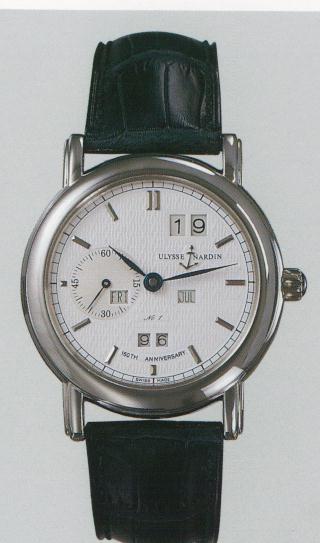
The Ulysee Nardin Perpectual Ludwig is a very beautiful rendition of the perpetual calendar. It is the first wristwatch which is able to have all its calendar functions adjustable via the single crown. Most other perpetual calendars require various pushpins to adjust the calendars, and even then, in the year 2100 would require a visit to the watchmaker to reset the gear train.
Note also the large double date first patented by Lange.
| The Gregorian calendar year is exactly 365 days, 5 hrs, 45 mins, and 46 secs, or mathematically expressed as 365.242192 days. To compensate for the slightly less than quarter of a day, every fourth year is a leap year, i.e. Feb 29 follows Feb 28, instead of Mar 1. By doing so, we have overcompensated by a few decimal places, so to correct for this, Feb 29 is ommited once every 100 years. However, even with
this correction, there is still a very small residue becomes undercompensated, and to take care of this, the leap year is untouched every 400 years. Even with this, the rounding errors amount to another exception to this once every 4000 years.
Hence, 1996 is a leap year. But since 2000 is a 400 year exception of the 100 year exception, it will be a leap year. But not 1900, 2100, 2200, and 2300. 2400 again be the exception, and will have Feb. 29.
|
The perpetual calendar is one of the classical complications. A perpetual calendar watch is mechanically programmed to adjust itself for the number of days in a month in each 4 yearly cycle. I have not come across a mechanical perpetual calendar which is programmed to handle any of the exceptions, hence, need adjustment to take care of these
It is a stroke of luck that no correction will be required for the year 2000, as the 400 year exception takes effect and it is indeed a leap year, although the 100 year exception says it is not.
Ulysee Nardin also makes several other very interesting watches, led by the Trilogy series of astronomical watches, and the animation sonnerie series.
More Girard-Perregaux
GP7000
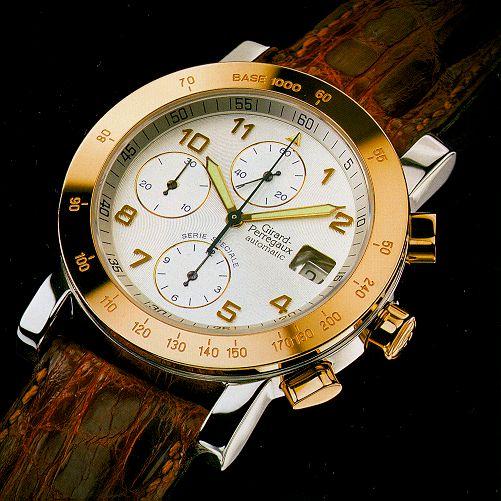
Girard Perregaux is one of the last few manufacture left in Europe.
A manu factur is the horological term reserved for houses who make all or
most of the watch in-house. Most importantly, it means that these houses
have the capability to build everything from scratch, including movements,
cases, bracelets, etc.
The GP7000 shown above was the first with this kind of case. Note the
shape of the pushers. Base movement is an ETA, with a chrono module. Click
on the image to see the platinum rattrapante. Note the attention to detail
and the classical lines of the case.
Phillipe Dufour
The independent watchmaker
Phillipe Dufour has made watchmaking history with the incredibly c
omlicated double escapement watch.
Click on the image of the watch to read a one-on-one conversation I
had with Phillipe.
More complicated than a tourbillion, the double
escapement ensures that the effects of gravity does not interfere with
the accuracy of the movement. This is the first attempt to make such a
complicated movement to be housed in a wristwatch which is available commercially.
Each watch is fashioned by hand by Mr. Dufour himself, using ancient
machines which he acquired. Indeed, watchmakers like him are a dying
breed.
Philipe Dufour is also famous for the Grand and Petite Sonnerie watches,
which chime the passing hours (en-passant) or on demand as in a minute/quarter
repeater.
| 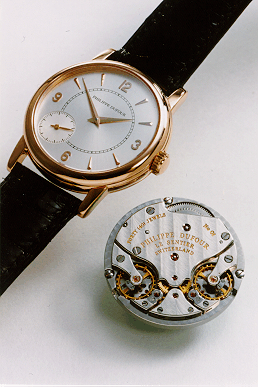
|
IWC
Der Doppelchronograph
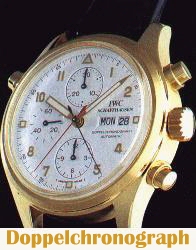
| IWC's very large and very impressive Doppelchronograph.
This is the rattrapante version of the famous Mk XI pilot watch. This
watch sports the ubiquitious Valjoux 7750 as a base. Of course, as is
typical of IWC, the base ebauche undergoes extensive modification before
it is considered suitable to reside inside an IWC case.
In this case the ebauche is polished, many parts exchanged for
nonmagnetic parts, the split-seconds hand module added and encased in an
antimagnetic enclosure.
|
The Grand Complication
| IWC's even larger and even more complicated watch is the
grand complication wristwatch. This marvel is a split seconds chronograph
(Rattrapante), a minute repeater, a perpetual calendar with 4 digit
year display, and the crowning glory: a flying tourbillion.
Watches of such complications are relatively uncommon in wrist watches
due to the smaller size of the case. The Patek Phillipe Caliber 96 is the
most famous pocket grand complication watch, bearing some 33 functions, and
weighing some 2 pounds.
| 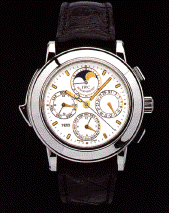
|
Frank Muller
The Frank Muller Double Face Chrono
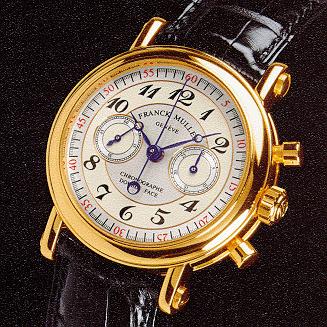
|
Very interesting from the master of complications Frank Muller.
This one features a double face
chronograph, where the tachymeter, telemeter functions are accesed from
the back of the case. The higher end of Frank Muller watches are very
exquisite in its execution, and attention to detail.
Frank Muller makes no fuss about using cheap base movements in his
creations. Often, a lot of work is invested in the case design, and the
execution of specific complications.
|
Patek Phillipe
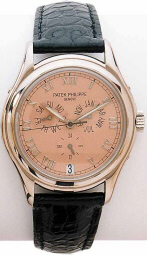
A gorgeous example of Patek Phillipe
artistry. Patek Phillipe is
considered the grand old dame of watchmaking. This famous house turns
extremely desirable pieces every year. Many of their older pieces have
fetched astronomical record prices at auctions.
The 5035 uses a the 315 automatic movement (inhouse by Patek) to
carry a patented annual calendar. The calendar is a simplified perpetual
calendar, where a
manual date change is required every year on March 1, to make the date
go from Feb 28 or 29 to Mar 1 with the pin pushers included. Patek
received numerous awards and a patent for this very practical complication.
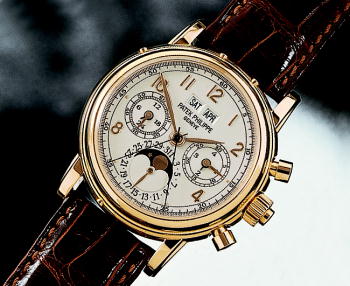
| Another classic Patek Phillipe. This rattrapante chronograph is also blessed with a moonphase and a perpectual calendar. The base movement is the new old stock Valjoux 22.
The Valjoux 22 is now out of production, and remains one of the most illustrious manual wind chronograph movements in history. Very beautifully finished, and excellent in almost every respect, it rivals the very famous automatic Zenith chronographs.
|
The house of Jaeger LeCoultre remains only one of few manufacturers to use only in-house movements. Exquisite movements and very beautifully finished. Financially belongs to the VDO group, which makes Lange Uhren and IWC sister companies.
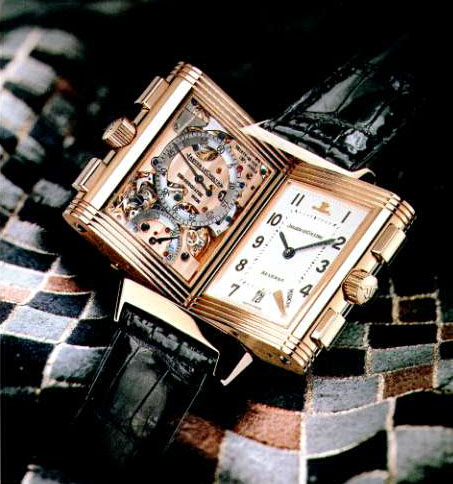
Jaeger Lecoultre's very nice chrono shown here in the famous Reverso
case. The Reverso case was originally developed in the 30s to allow
sporting gentlemen to go about their sport without smashing the glass
of their watches. The ingenius method was to allow the entire case to
pivot about a point and swing around. And so as not to clutter the dial
design, the chrono functions/hands are at the reverse side.
The reverso case also allows for the back to be engraved with the owners crest
of arms, or some personal message. Or for another dial to be put, as is
the case for the duotime and this chronograph:
Blancpain
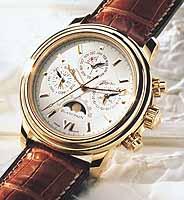
| Blancpain is the oldest watchmaking company in the world. Established
in 1735, it holds the distinction of never having made a quartz watch.
The company actually ceased to exist during the quartz era of the 70s,
and was revived by the SMH group subsequently.
Shown here is a top grade Blancpain chrono with perpectual calendar:
|
Vincent Calabrese
Vincent Calabrese is another talented independent watchmaker. Shown
here on the right is the Day/Night. Known for the simple dial designs, the
Day/Night features hour markers which appear in white for day and black
for night. This is accomplished by perforating the dial at the locations
of the hour markers, and for a disk containing two sets of hour numerals
which rotates one position every 12 hours and reversing. Another very innovative complication.
Other Calabrese complications include the mystery hour, and a personal collection,
where the movement appears suspended within the case, and Calabrese is able to
craft the movement to be shapped after a chosen alphabet or map of a country!
|
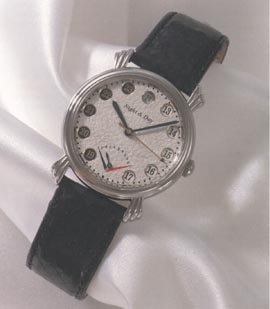
|
Zenith
The house of Zenith is most
famous for their unique and excellent movements. Their unrivalled
superiority in chronograph movements is statement of their capability.

| There 2 basic variations in their chronograph movements, viz
caliber 400 and 410. Both are based on classical chronograph movements.
The 400 is the simpler of the two, and the 410 has triple date. Shown
here at the left is the Rainbow. This watch is waterproof, and is made
in tribute to the America's cup yatch of the same name.
Click on the image for a picture of the triple date Chronomaster,
which is an example of a Zenith watch using the 410 movement.
The 400 movement used in this example runs at 36,000 bph. This
allows the chronograph to measure up to 1/10 th of a second. This very
same movement is used in the very famous Rolex Daytona Cosmograph,
although Rolex had modified the movement making it run at 28,800 bph.
The superlative El Primero chronograph movement is also used in the
Rolex Daytona Cosmograph (Rolex buys the base ebauche sans escape/rotor,
and uses its own slower beat 28,800 bph escape) and the best example in
the Daniel Roth chronograph. |
Zenith has also made some headlines amongst the watch community with
their ultra-thin Elite movement. This is featured in tehir Class 6 watches.
My Comments: Although the movements are exceptional, the Z
enith case designs are pedestrian at best.
Daniel Roth
Another very young and talented watchmaker: Daniel Roth. Shown here at
the left is one example
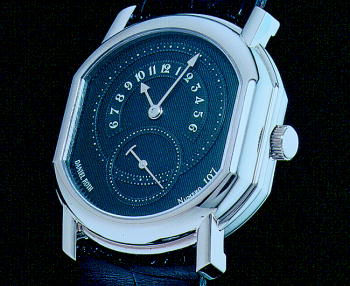
| of his mastery of the art of watchmaking. The unique case design,
charateristic of Roth creations, and the retrograde hands are testimony
enough.
Retrograde hands presents significant difficulty for the watchmaker.
When the hand reaches the 6 hour marker, which is place at the
traditionally 4 o'clock position, it suddenly springs backward to the
traditional 8 o'clock position, also marked 6.
This complication is a curiosity, but makes glancing at the time not
intuitive.
Roth also makes a full line of watches, like the chronograph mentioned
above. Tourbillions are another speciality of the Roth line.
|
<
Rolex
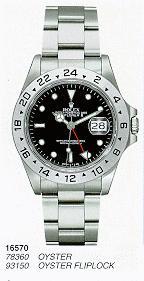 The name of Rolex is
almost synomyous to quality watchmaking, at least in the eyes of laymen.
And they have a right to that crown. Rolex is a very established house,
uses in-house movements for almost all of their watches (a notable
exception is the very famous Daytona Chronograph, which uses a modified
Zenith 400 movement).
Shown right is the obligatory Rolex image. I am not extremely fond of
Rolexes, but the Explorer II is one of my favourites.
The name of Rolex is
almost synomyous to quality watchmaking, at least in the eyes of laymen.
And they have a right to that crown. Rolex is a very established house,
uses in-house movements for almost all of their watches (a notable
exception is the very famous Daytona Chronograph, which uses a modified
Zenith 400 movement).
Shown right is the obligatory Rolex image. I am not extremely fond of
Rolexes, but the Explorer II is one of my favourites.

Take me home
This page was created by Peter Chong. Last updated January 16, 1998.













 The name of Rolex is
almost synomyous to quality watchmaking, at least in the eyes of laymen.
And they have a right to that crown. Rolex is a very established house,
uses in-house movements for almost all of their watches (a notable
exception is the very famous Daytona Chronograph, which uses a modified
Zenith 400 movement).
Shown right is the obligatory Rolex image. I am not extremely fond of
Rolexes, but the Explorer II is one of my favourites.
The name of Rolex is
almost synomyous to quality watchmaking, at least in the eyes of laymen.
And they have a right to that crown. Rolex is a very established house,
uses in-house movements for almost all of their watches (a notable
exception is the very famous Daytona Chronograph, which uses a modified
Zenith 400 movement).
Shown right is the obligatory Rolex image. I am not extremely fond of
Rolexes, but the Explorer II is one of my favourites.
